Whole system approach to young people who offend: evaluation
An evaluation of our Whole System Approach (WSA) to young people who offend in Scotland.
3. Implementation of the Whole System Approach to Youth Offending
This section of the Report describes the implementation of the WSA in each of the three selected local authorities, and comments on the challenges and successes on the WSA's main work stream activities, namely Early and Effective Intervention, Diversion from Prosecution, and Other Components, including Court Support, Alternatives to Custody and Secure Accommodation.
Responding to Objective 1 (the extent to which WSA work stream activities have been implemented to date) and Objective 3 (addressing the mechanisms of partnership working in the case study areas) this section discusses how the short and medium term outcomes of WSA have been achieved in each local authority, how the methods and practices in each area differ, and the reasons for these differences, with an emphasis on mechanisms of partnership working. Quantitative and qualitative data are used to demonstrate the operation and effectiveness of each work stream, alongside discussions of how the WSA has been implemented in each local authority so as to better inform lessons for sustainable practices in the future.
3.1 Early and Effective Intervention
Early and Effective Intervention ( EEI) aims to deliver a timely, appropriate and proportionate response to young people aged between 8 and 17 years reported for offending. The key objectives are:
- to ensure children are only referred to the Children's Hearing system where it is likely that compulsory measures will be required (to reduce the number of inappropriate referrals);
- to support a faster and more focused response to those reported for offending;
- to promote better information-sharing and more consistent decision-making;
- to reduce anti-social behaviour and re-offending rates;
- to work within the Getting it Right for Every Child ( GIRFEC) framework to ensure the young people receive appropriate help from a coordinated multi-agency forum.
EEI operates using the pre-referral screening process ( PRS), [4] which diverts young people away from the formal criminal justice system. Young people aged 16 and 17 years became eligible for PRS in September 2013. Prior to this, eligibility was limited to 8 to 15 year olds. In some authorities eligibility is extended to young people on supervision [5] (taking into account the number and type of previous involvements), however this varies across Scotland. The PRS process, as broadly practiced, is illustrated below in Figure 3.1. Note that this structure is not definitive and that there may be some variation between local authorities, in regard to the decision-making process, and the outcomes available to stakeholders.
Figure 3.1 Whole Systems Approach
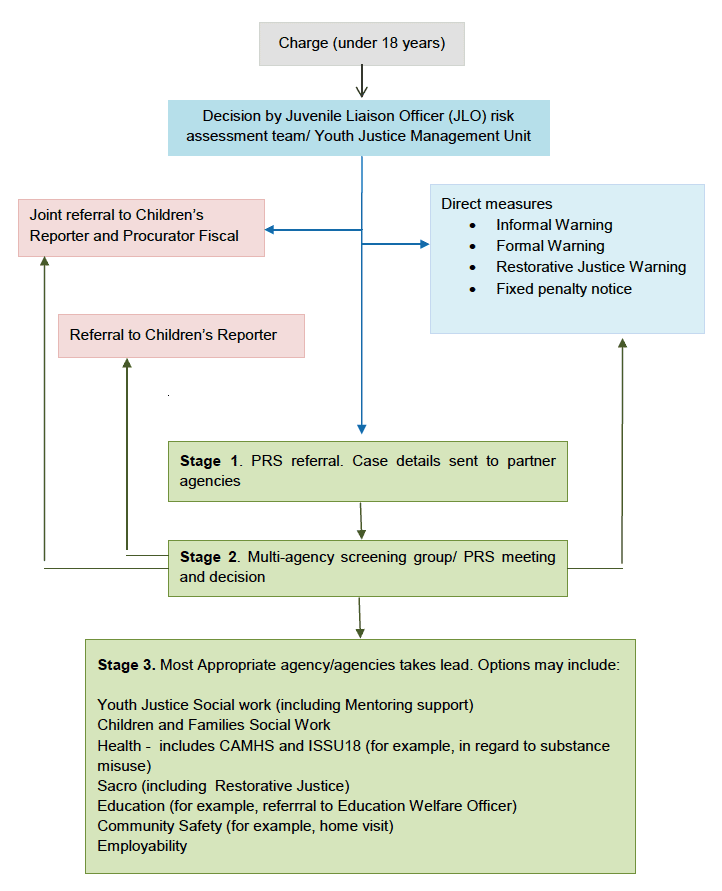
3.2 Pre-referral screening: charges and referrals
The PRS process is triggered by a police charge. Police charges in relation to those aged 17 years and under are referred in the first instance to Police Juvenile Liaison ( JLO) [6] staff risk assessment team, who consider whether: a case is suitable for early diversion; should be referred to the Scottish Children's Reporters Administration ( SCRA); or should be jointly referred to SCRA and the Procurator Fiscal. If a case is not suitable for early diversion, a full 'Standard Prosecution Report' will be requested from the reporting Police officer and a joint referral made to the Children's Reporter.
In each Authority, the role of the police in directly facilitating the WSA appeared to be well-established and evidenced by good working relationships. JLOs were attuned to the importance of communicating WSA values to their front-line colleagues, and reiterating the message that by reducing the likelihood of prosecution for young people, more police time could be spent addressing serious crime. JLOs acted as WSA 'champions' (see section 5.4) within each organisation, spending considerable time and resource in facilitating face-to-face briefings in order to communicate the WSA's importance. As such, JLOs acted as drivers of change within Police Scotland. The wide scope of the JLO role in one local authority is described below.
"I'm a police officer in the Concern Management Hub at X Police Office. As part of my role, I deal with the SCRA, which is the Children's Reporters Office, which deal with juvenile offending and concerns for children. I also deal with social work for child concerns and with the local care establishments, where we have registered residential units. So I deal with the care staff there, on a kind of daily basis. I also deal with youth offending, up to and including persons aged 17… In Police Scotland, if someone commits an offence, we raise what we call a crime report. Officers also have to raise a concern form, which identifies the crime that has been committed, but also wider concerns for the child. That gets submitted to our department. I deal with mainly the youth offending ones. I'll do additional checks and then decide what is the best disposal for that offence and that child."
Cases identified as suitable for early diversion are discussed at multi-agency meetings with a range of partners. Each partner has the authority to access and share confidential client information, and decision-making responsibility for cases under discussion. Partners also accept the responsibility to divert cases to their respective agencies, if appropriate. The main points of discussion at multi-agency meetings concern:
- Who is currently working with the young person;
- Offending and welfare concerns;
- Identification of both risk factors and protective factors;
- Agreement of the most appropriate agency for diversion, or;
- Agreement that the case should be referred to SCRA or the Procurator Fiscal on the grounds of welfare needs and/or persistent offending.
Within the PRS process, offending behaviour is treated as a flag for welfare concerns, rather than a substantive issue in its own right. Information sharing enables decision-making to be informed by young people's circumstances, and alerts partners to concerns before they warrant prosecutorial action:
"Because we're all at PRS, there's Community Safety there as well, you can get to find out about instances of anti-social behaviour that don't warrant a police charge, but about behaviour that's going on. So it's more about a pattern of behaviour for that young person, as opposed to offending, that gives cause for concern." (Young People's Services)
The diversity of expertise held by PRS partners allows the group to respond to an array of welfare concerns in a swift and informed fashion. The PRS process is a vital component in promoting information sharing between partners, whilst the face to face nature of PRS develops trust and professional understanding. Information sharing also facilitates better outcomes regarding young people's welfare by providing a fuller picture of the causes/context of offending behaviours:
"Now it's going to somebody, maybe a named person. And they might not be doing something too significant about it - but they know about it and they keep an eye on it… Prior to that it was only the police and SCRA that had all that information. No-one else knew. Whereas, if there's been three or four nuisance things in a couple of months, you can get a sense that there's something not right going on." (Young People's Services)
Details of cases deemed appropriate for PRS are forwarded to partner agencies (Education, Young People's Services etc.) for consideration ahead of the PRS meeting (stage 1). At the PRS meeting, partners discuss cases and collectively decide upon the outcome.
Eligibility for PRS varies across authorities. For example, in Authority A, children and young people with a supervision requirement are not eligible for PRS. By contrast, in Authorities B and C, 14 and 308 children with a supervision requirement were referred to PRS in 2013/14 respectively.
Authority B provided some data on police charges, which act as the starting point to PRS. Table 3.1 provides a snapshot of charging data for 2013/14, and shows the proportion of young people allocated police direct measures, referred to the Reporter and referred to PRS.
Table 3.1 Young people charged by the police and outcomes, 2013/14
| Male | Female | |||
|---|---|---|---|---|
| Number of young people: | 12 to 16 | 16/17 year olds | 12 to 16 | 16/17 year olds |
| Charged with an offence | 1048 | 322 | 289 | 78 |
| Issued with police direct measures ( PRS Notified) | 88 (8%) | 18 (6%) | 34 (12%) | 13 (17%) |
| Referred directly to Reporter | 377 (36%) | n/a | 124 (43%) | n/a |
| Jointly referred to Fiscal/ Reporter; referred to Fiscal | 121 (12%) | 283 (88%) | 16 (6%) | 55 (7%) |
| Referred to PRS | 462 (44%) | 21 (7%) | 115 (40%) | 10 (13%) |
| Total | 100% | 101% | 101% | n/a |
Source: Police Scotland, 2015
Table 3.1 shows that in 2013/14, 1,337 charges were raised against under-16s, and 400 were raised against 16 or 17 year olds. Within the age groups, a higher proportion of under-16s were referred to PRS (44% males, 40% females), compared to those aged 16 or 17 (7% males and 13% females). In other words, under-16 year olds were more likely to be diverted using PRS than 16 or 17 year olds; however, it is difficult to make a direct comparison without knowing the nature of the cases or charges.
This entry level data is important and can enable practitioners to track the early flow of young people through the system. Police charging data can also be used to monitor the proportion of re-referrals over time - and those who do not accrue further charges. The latter group, those who do not accrue further charges, are the 'successes' of the WSA. However, the fact that the most successful cases are those which no longer come to the attention of the authorities makes evaluation difficult. Existing literature on desistence may be useful in this respect, with a view to identifying methodological approaches and/or sources of data that allow us to capture and understand pathways to non-offending (see Sampson and Laub, 2001: 54).
Figure 3.2 below shows the number of offences committed by young people aged under 16 who were referred to PRS in Authority C between 2008/9 and 2013/14, broken down by gender. The raw data are included in Appendix C (this includes data for 16/17 year olds which were only available for 2013/14). These data show that males were more likely than females to be referred to PRS for most offence types, but that the number of referrals for both males and females reduced gradually over the 6 year period.
There are also some marked gender differences. Alcohol referrals for females were particularly high in 2008/09; however, this fell dramatically in 2009/10, and was subsequently lower than for males each year. Theft referrals for females peaked in 2010/11, at a higher number than for males, but also subsequently fell back to levels below that of the males. Most interestingly, the number of assault referrals was particularly high for females, and was higher than for males in 2009/10 and 2012/13.
Over time, there was a gradual increase in the proportion of all PRS referrals which were made for females, from 29% in 2008/09 to 51% in 2012/13, although this fell back to 24% in 2013/14. The number of females referred to PRS in relation to assault in 2012/13 is particularly marked. Indeed, 74 per cent of all PRS referred cases involving assault by under-16 year olds in authority C in that year were for females. Whilst it is not possible to draw more robust conclusions from these data, it is possible that decision-making in regard to referrals is partly gendered. This means that the probability of referral to PRS for females may be higher than for males, resulting in greater leniency towards females - or the application of more stringent criteria towards males.
Figure 3.2 Young people aged under 16 referred to PRS by offence type and gender
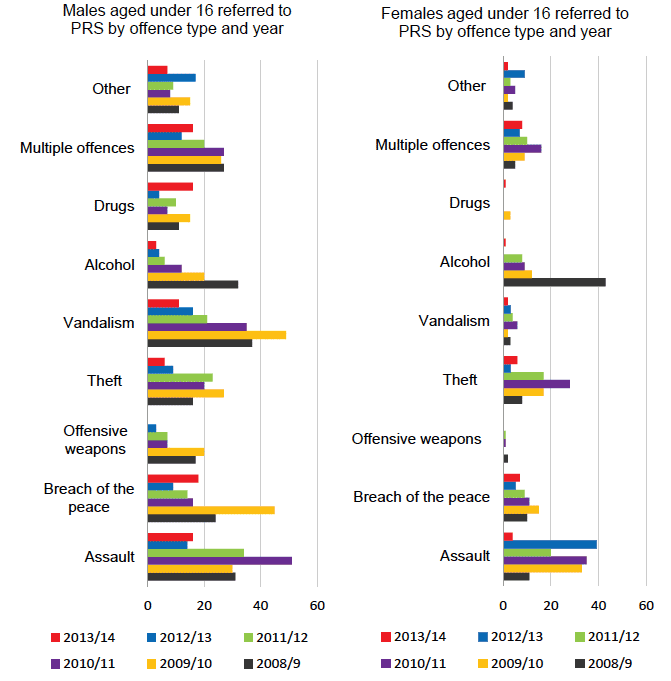
Below, Figures 3.3 and 3.4 show the number of young people referred to PRS in Authorities A and C between 2009/10 and 2013/14, broken down by age group (similar data for Authority B could not be obtained).
Figure 3.3 Number of young people referred to multi-agency meetings: Authority A
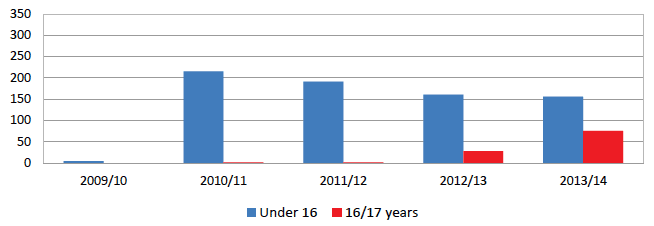
Looking at the under-16s, in Authority A, there was an 8 per cent decrease in multi-agency referrals from 2010/11 onwards; whereas in Authority C, there was a 43 per cent decrease in multi-agency referrals from 2009/10 onwards. The number of 16 and 17 year olds referred to PRS was small compared to the number of under 16s in Authority A in 2012/13 when this was first introduced; however, this seemed to have increased markedly in 2013/14. In Authority C, 16 and 17 year olds were referred for the first time in 2013/14, so no trend is discernible.
Figure 3.4 Number of young people referred to multi-agency meeting: Authority C
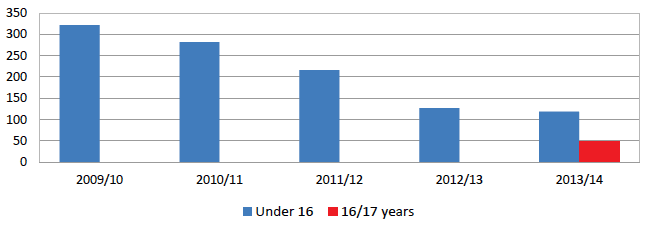
It is not possible to quantify the extent to which the fall in referrals is related to the WSA practices employed by the local authorities, however the overall trends are encouraging, and consistent with falling levels of recorded youth crime in Scotland. It is too early to assess trends in relation to 16 and 17 year olds. Nonetheless, the initial increase in referrals in Authority A suggests successful engagement with the older age groups. Looking ahead, the number of 16 and 17 years olds referred to PRS might be flagged as a key indicator for the WSA.
Changes in the number of referrals to PRS impacted differently on the three authorities. In Authority A, the fall in referrals had allowed the local authority to look to expanding their services to older age-groups. Conversely, in Authorities B and C, it remained a challenge to maintain the WSA at the current level. This was primarily due to the pressure placed on resources, including the cessation of seed funding in Authority C.
3.3 PRS Outcomes
A range of outcomes are available to partner agencies, including: police warning letters; diversion to Education (for example, discussions with a Head Teacher or Education Welfare Officer); allocation to a social worker; diversion to community safety (for example, a home visit by a community safety officer); or referral to the Children's Reporter. If a young person refuses to engage with the service offered, the case is referred to the Children's Reporter. [7]
Given that some young people will be allocated more than one service, it is not possible to map EEI actions on an individual basis. However, analysis of the services and agencies made available to young people shows variation between local authorities which can be broadly grouped into statutory agencies (for example, education, social work, community safety, Children's Reporter); and external agencies (such as Sacro and Barnardo's).
Of those actions allocated by Authority A between 2009/10 and 2013/14, cases were split more or less evenly between formal and external agencies. Approximately 53 per cent were allocated to Sacro, which acts in an independent capacity. A further 15 per cent were allocated to Youth Justice Social Work; eight per cent received a 'no further action' letter'; four per cent were referred to the Reporter; three per cent were allocated to drug and alcohol services, and the remaining 17 per cent were allocated to 'other' services or agencies, including adult social work services, CAMHS, health, and children and families social work. Less than one per cent of cases were referred on to the Procurator Fiscal.
In Authority C, a more formal set of responses was evident. For example, 16 per cent of cases were referred to the Reporter; 18 per cent were referred to 'Restorative Justice, Mediation and Parenting Support Service' ( RaMPS); 10 per cent received police current measures; 10 per cent were referred to youth drug/alcohol service; 10 per cent were referred to the anti-social behaviour terms; nine per cent received a restorative justice warning; and five per cent were allocated to Education. Sacro services were not used by Authorities B and C in relation to the WSA.
The capacity for information-sharing and decision-making was, to some extent, influenced by practitioner remits, specifically whether a practitioner had an authority-wide or a local remit. In the latter case, decision-making was sometimes limited by a lack of oversight.
"I can talk quite comfortably about all the things that are happening in [my area]… [but for other areas] all I have to work on is the bullet points… I just work from the notes… and if they haven't given me very much, I can't embellish on that." (Community Safety).
PRS outcomes were also influenced by service provisions in the respective authorities. For example, a strong third sector presence in Authority A was not replicated in Authority C:
"Everybody has got access to, for example fire service, police and social work, and education. But if you're starting to think about targeted interventions [for example] Restorative Justice or drug and alcohol education, you are looking more at the likes of Sacro and Action for Children… Some of the contracts for these services don't exist in some areas across the country... every local Authority needs to have a way of referring and accessing that system." (Young People's Services).
The PRS process, in terms of allocating actions to partner agencies, functioned well in each authority. Building on this observation, it would be beneficial to unpack the different factors and rationales that inform PRS outcomes, with a view to minimizing inconsistencies in the opportunities and services made available to young people (for example, in terms of gender, and the types of services made available). Differential access to resources (in terms of availability) could also be examined, for example, with a simple audit of the key services available and used in each authority, with a view to sharing resources where appropriate.
3.4 Diversion from Prosecution: 2005/6 to 2013/14
Diversion from prosecution is a formal decision made by the Procurator Fiscal. In the case of minor offences, the Fiscal may decide to refer the case to criminal justice social work, rather than prosecuting through the courts or offering fiscal direct measures. In such cases, prosecution may be made subject to successful completion of the scheme. Diversion programmes include Restorative Justice Programmes and Social Work diversions. A more detailed overview is provided in Appendix D. Figure 3.5 shows the number of diversion cases commenced for 16 and 17 year olds in the 3 authorities between 2005/6 and 2012/13.
Figure 3.5 Diversion from prosecution, 16 to 17 year olds, 2005/6 to 2012/13 (cases commenced)
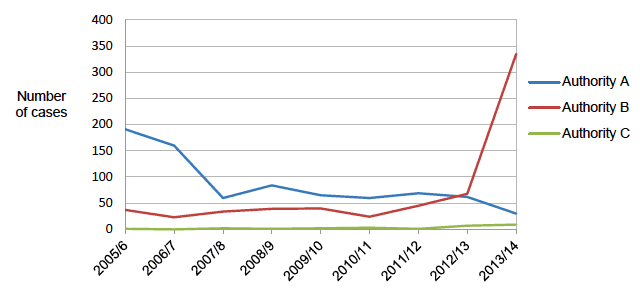
Source: Scottish Government Criminal Justice Social Work statistics
As can be seen, the use of diversion in Authority A decreased markedly prior to 2007/8, and stabilized thereafter. Diversions in Authority B fluctuated from year to year, with an increase from 2010/11 onwards culminating with a massive spike in 2013/14. In Authority C, the use of diversion is minimal over the entire period.
Below, Figure 3.6 shows the per capita rate of all cases diverted per 10,000 16 and 17 year olds between 2005/6 and 2012/13. This confirms a large early decline in diversion per capita in Authority A, with very little change thereafter; however in Authority B, following a steady trend, there has been a recent sharp increase in the use of prosecutorial diversion for 16 and 17 year olds.
Figure 3.6 Diversions per 10,000 2005/6 to 2012/13, 16 and 17 year olds
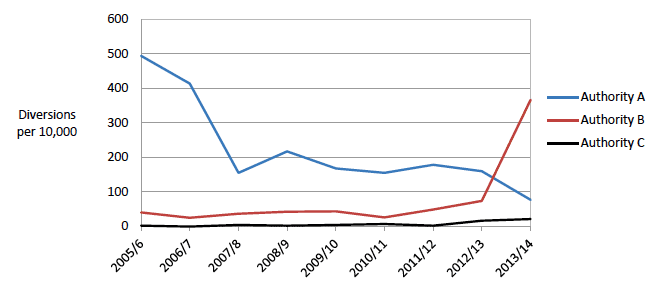
Calculations based on 2011 mid-population census estimates
Source: Scottish Government Criminal Justice Social Work statistics
Figure 3.7 shows that the overall use of diversion (for all ages) appeared to increase significantly in Authority B, again with an upward trend since 2011/12 (although not in the other two areas).
Figure 3.7 Diversion from prosecution (all ages) 2005/6 to 2013/14 (cases commenced)
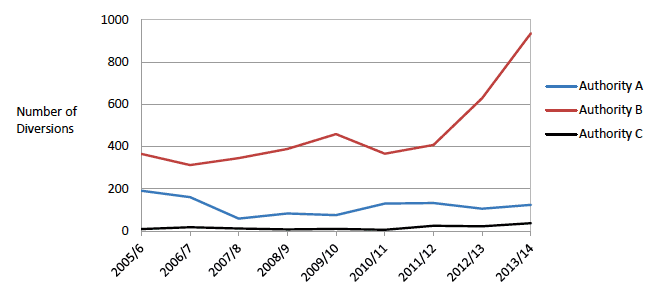
Source: Scottish Government Criminal Justice Social Work statistics
Looking in more detail at the age profile of those diverted from prosecution within each of the three areas from 2005/6 onwards reveals some interesting differences in practice. Figures 3.8 to 3.10 show the percentage age-distribution of diversion cases within the three local authorities. The data show that the overwhelming majority of diversions in Authority A pertain to younger age-groups, whereas in Authorities B and C, young people account for a smaller proportion of all diversions.
Figure 3.8 Diversion from prosecution: cases commenced by age-group (%) Authority A
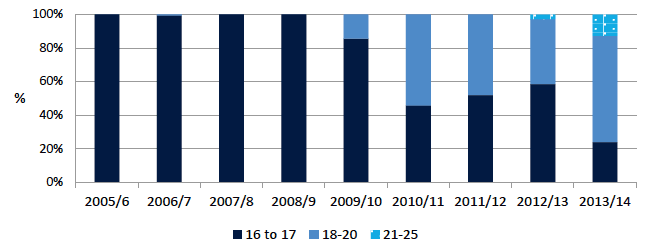
Figure 3.9 Diversion from prosecution: cases commenced by age-group (%) Authority B
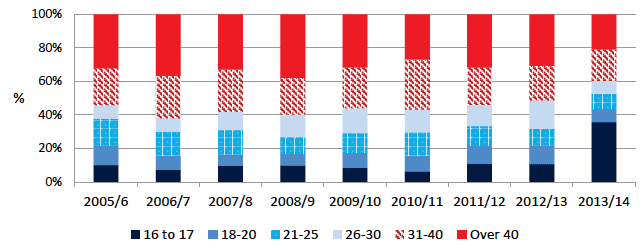
Figure 3.10 Diversion from prosecution: cases commenced by age-group (%) Authority C
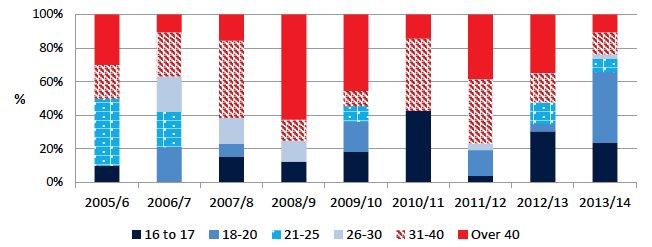
Source: Scottish Government Criminal Justice Social Work statistics 2014
In Authority A, diversion was used moderately and reserved for young people (see Figures 3.5, 3.6 and 3.8). There were no diversions among those aged 26 years and over across the entire period, whilst all diversions prior to 2008/9 involved those aged between 16 and 17 years. The expansion of diversion to those aged between 18 and 20 years in 2009/10 shows a change in policy and practice, which is in line with expanding GIRFEC to young adults up to the age of 21. Below, practitioners comment on how a young person's age does not necessarily reflect their maturity.
"It's a short intervention to try and get things back on the straight [and narrow]… These young people, although they're 18 up to 21, they're not by any means ready for the adult world, to go out there and face it on their own".
"Bear in mind diversion is awareness. It's as simple as that and what they take away from it: it's up to them. They're not on an order. It's also voluntary and if they don't want the service in the first instance, they can have their day in court…. What would they benefit from a fine or a breach of the peace charge and getting put on some sort of order? It's not addressing the offence. Particularly in the older ones, they think they know everything and they don't… so it's great".
In Authority B, the use of diversion between 2005/6 and 2012/13 was comparatively high, reserved primarily for older adults ( Figures 3.5, 3.6 and 3.9). For example, between 51 per cent and 62 per cent of cases involved those aged 31 years and over. By contrast, in Authority C, the use of diversion was low, with no clear trends in terms of age ( Figures 3.5 , 3.6 and 3.9). For example, the proportion of diversion cases involving 16 and 17 year olds ranged from zero in 2006/7; to 43% in 2010/11.
3.4.1 Diversion and gender
There is some limited evidence that diversionary decision-making may be weighted towards young women and girls. Table 3.2 shows that the overall proportion of females diverted from prosecution in Authorities B and C between 2005/6 and 2012/13 was higher than might be expected compared with males, given that what we know about the extent of women's involement in crime . For example, in the 2010/11 sweep of the Scottish Crime and Justice Survey, of those respondents who could state the gender of the offender, 74 per cent said the offender was male (Scottish Government, 2011a; 43, 3.5.3), whilst data from the Edinburgh Study of Youth Transitions and Crime shows that of those aged 12 to 17 who reported being involved in violent behaviour and serious offending, 86 per cent and 66 per cent respectively were male (McAra and McVie, 2010; 67). Whereas, the average percentage of diversion cases involving females was just over 50% in both Authority B and C. In Authority A, the proportion of females to males is more in line with what we might expect, with an average of 18% of diversion cases involving females .
Table 3.2 Diversion from prosecution cases (all ages) by gender, cases commenced 2005/6 to 2012/13
| A | B | C | |||||||
|---|---|---|---|---|---|---|---|---|---|
| Male | Female | Total | Male | Female | Total | Male | Female | Total | |
| 2005/6 | 85% | 15% | 191 | 50% | 50% | 366 | 50% | 50% | 10 |
| 2006/7 | 87% | 13% | 161 | 46% | 54% | 313 | 32% | 68% | 19 |
| 2007/8 | 73% | 27% | 60 | 42% | 58% | 346 | 31% | 69% | 13 |
| 2008/9 | 80% | 20% | 84 | 45% | 55% | 389 | 62% | 38% | 8 |
| 2009/10 | 82% | 18% | 76 | 49% | 51% | 459 | 55% | 45% | 11 |
| 2010/11 | 82% | 18% | 131 | 48% | 52% | 367 | 43% | 57% | 7 |
| 2011/12 | 88% | 12% | 133 | 61% | 39% | 408 | 54% | 46% | 26 |
| 2012/13 | 78% | 22% | 106 | 55% | 45% | 629 | 61% | 39% | 23 |
Source: Scottish Government Criminal Justice Social Work statistics 2014
Bradford and MacQueen suggest that the higher proportion of diversion cases involving females may be explained by cases involving older women, who they found to be more likely to be diverted from prosecution (2011; 2.13f).
Table 3.3, which provides a more detailed breakdown of diversion referrals by age group for Authority B suggests that this is partially true, since the proportion of diversion cases involving females did increase steadily by age group from age 16-17 to age 36-45; however, after this age it proceeded to decline again. Therefore, there is not a clear linear relationship between age and likelihood of diversion from prosecution.
Table 3.3 Diversion referrals by age-group and gender, Authority B, 2013/14
| Age-group | % Female | % Male | Total |
|---|---|---|---|
| 16-17 | 27% | 73% | 189 |
| 18-21 | 42% | 58% | 50 |
| 22-25 | 53% | 47% | 38 |
| 26-35 | 54% | 46% | 102 |
| 36-45 | 61% | 39% | 64 |
| 46-55 | 38% | 62% | 37 |
| 55 and over | 26% | 74% | 39 |
| Total | 519 |
Source: Authority B, Criminal Justice Social Work statistics 2015
These findings appear to echo the analysis in section 3.2 which showed that referrals to the PRS appeared to be weighted towards females - although it should be noted the evidence is similarly limited. As such, this is an area that might be flagged for further investigation.
3.5 Fiscal fines and warnings
Fiscal fines and warnings offer a less punitive alternative to prosecution, although like police fines and warnings, these are not strictly diversionary. Under s.302 of the Criminal Procedure (Scotland) Act 1995 the Procurator Fiscal has the discretion to offer a fiscal fine in relation to any offence in respect of which an alleged offender could be competently tried before a district court. If the accused accepts (and subsequently pays) a fiscal fine, no prosecution is brought and no criminal conviction is recorded. The Fiscal is also empowered to make an offer of a fixed penalty as an alternative to prosecution for various road traffic offences, such as speeding and driving without insurance. If a fixed penalty is accepted, it is recorded as a criminal conviction. In 2013/14, over 1,300 fixed penalties were issued to 16 and 17 years olds, of which, 74 resulted in a criminal record.
Figure 3.11 shows the number of direct measures issued by the Crown Office and Procurator Fiscal Service ( COPFS) to 16 and 17 year olds between 2008/9 and 2013/14. These data could not be provided at local authority level. This figure shows an overall fall in the use of all four types of COPFS fixed penalties and fiscal fines from 2008/9 onwards for both 16 and 17 year olds.
Figure 3.11 Number of COPFS fiscal fines, 2008/9 to 2013/14 (16 and 17 years)
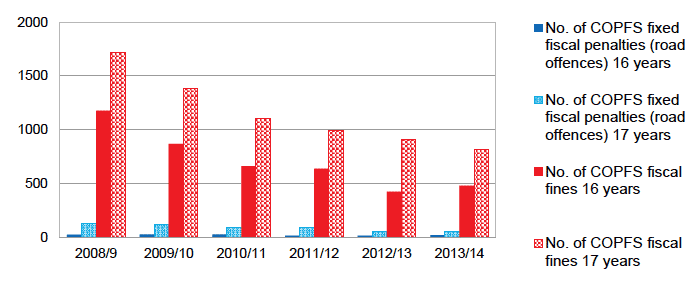
Source: Scottish Government (2014b) Criminal Proceedings 2013/14
3.6 Diversion from prosecution
Taking an overview of the three local authorities, the varying levels of diversion are difficult to explain. In this respect the data appear to support Bradford and MacQueen's finding that 'there is significant variation in the use of diversion across Scotland and over time that cannot be accounted for by population or crime rates' (2011: 3). Similarly, it does not appear to have been heavily influenced by the implementation of WSA.
In one authority, it was suggested that decision-making was adversely influenced by a churn of staff, and a large marking team, which resulted in a less consistent approach. One practitioner in a different authority referred to a previous lack of 'buy-in' by the Fiscal service, although a change of personnel meant this had now been resolved. Whilst good working relationships sustained the use of diversion, a reliance on interpersonal relationships also lent a sense of precariousness to the process (also see Bradford and MacQueen, ibid.).
For the Fiscal service, geography can present a challenge, in terms of liaising with different WSA contacts. In Authority C, a limited third sector presence was perceived to limit the scope for diversion insofar as the options and services available were limited. However, the local authority had also tailored available diversion programmes and practices in order to counter this shortfall.
Variable patterns of diversion are likely to result from relatively high levels of autonomy within the prosecution service (Pakes, 2010: 69, Duff, 1999). With this observation in mind, key practitioners in all three authorities suggested that diversion from prosecution may function more effectively if the default position was diversion; and the onus was placed on the Procurator Fiscal to justify prosecution for 16 and 17 year olds, rather than vice versa. It was also suggested that young people could benefit from support whilst awaiting a decision by the Procurator Fiscal.
3.7 Court Support
Court Support aims to speed up the court process where young people have to be prosecuted, and to support young people with the aid of a court support worker. Practitioners across authorities lauded the court support service and acknowledged the value it has for both informing young people of what to expect and supporting them through what is often a stressful experience. As one practitioner said:
"Sometimes it's just to have somebody there to boost their morale… I find they're confused about what they're actually charged with, why they're there, a lot the time they think they're going to go to prison when that's actually not even a possibility, but they think it might be and they get themselves quite het up about it."
Some practitioners expressed frustration at factors that were out of their direct control. These included lengthy delays in cases, and the prolonged use of supervised bail, which raised concerns should the young person be found not guilty.
"There's still huge opportunities to be dealing with those who are going to the adult criminal justice system… because they're not being fast-tracked in any way… It's still taking up to a year, if not longer than a year for a case to be dealt with." (Young People's Services).
Concerns were also raised in relation to missed opportunities to provide support and services for young people because of the time that it took for cases to be disposed of by the courts, especially when the outcome indicated that a diversionary approach would have been appropriate:
"Often we find when the case gets to court that, maybe a year after, down the line, the person will end up being convicted at the trial and be admonished, and there's a lot of good work that has been done in the intervening period where we, if we had known that a year from making the decision to prosecute, that the person was going to be admonished." (Young People's Services)
The structure of court support services varied across local authorities. For example, some authorities commissioned court services, whilst others undertook the work in-house. One manager commented on the advantages of in-house services, which allowed control of the process and culture, and the allocation of skilled staff to more demanding cases.
"I use [social worker] exclusively for the much higher risk kids who are in and out of secure, going to hearings, going to court. [Social worker] also built up a really good rapport with our most difficult lawyers we dealt with at court, and they used him a lot, liaised with him a lot as well".
Authorities found it difficult to access court data and monitor the number of young people who had missed scheduled court appearances. This was felt to be a strong barrier to determining the impact of court support services.
"When I first started to get involved with WSA, one of the things I was really interested to know was by putting additional resources in to court support, did that have any direct impact on the number of young people who were appearing in court, or failing to attend? That data was never able to be obtained… therefore I don't know if the court support that we put in place has had any impact on that. The commissioned service that we use in their pilot report has suggested anecdotally that it did have an impact, but I don't know whether or not it actually did." (Young people's services)
Whilst EEI is often referred as being distinct from the WSA, practitioners' reflections on the need for court support and diversion programmes shows how, despite the more intensive nature of processes that extend out from and beyond EEI, those young people are still viewed as vulnerable and requiring of support. Reflecting this welfarist perspective, one practitioner said:
"Because we're seeing youngsters through to 18 then we are getting young people whose needs were maybe more complex … who may have been working with children and families and because they were on supervision they tended to stay with children and families despite the offending which we didn't really know about. … It's a generalisation but the supervision orders tended to stop when they reached 16 or left school, so these are very demanding cases that disappear and tend not be involved in a positive destination and where really many of them would just graduate to the adult criminal justice system."
Participants in this study were of the view that an effective EEI programme allows for the accommodation of and, where appropriate, the prioritisation of more problematic cases. Needless to say, the expansion of EEI to include working with an older age group of young people necessarily requires highly skilled and dedicated WSA workers, preferably co-located, so as to be able to respond to complex and intensive needs of this group swiftly.
3.8 Alternatives to custody and secure care
Scottish Government policy states that when a young person appears at court, alternatives to secure care and custody should be explored and that custody should be a last resort. Where custody is imposed, secure care should be used whenever possible as an alternative to prison (Scottish Government, 2011c). At the national level, admissions to prison by direct sentence have fallen sharply: from 512 receptions in 2002/3 to 296 receptions in 2010/11 since 2002/03, which equates to a 42 per cent reduction.
Table 3.4 Authority C, number of 16-17 year olds; on bail; remanded to secure care or custody; in secure care; in custody (2008/9 to 2014/15)
| Number of 16/17 year olds | 2008/9 | 2009/10 | 2010/11 | 2011/12 | 2012/13 | 2013/14 | 2014/15 |
|---|---|---|---|---|---|---|---|
| On bail (alternatives to remand) | 5 | 12 | 10 | ||||
| Remanded to secure care/custody 1 | 2 | 6 | 5 | 10 | 14 | 7 | 7 |
| In secure care on offence grounds | 2 | 1 | 0 | 1 | 1 | 2 | |
| In custody | 6 | 5 | 4 | 5 | 6 | 2 | 2 |
| Receiving intensive support as alternative to secure care/custody | 9 | 15 | 9 | ||||
| Actively reintegrated from custody | 0 | 2 | 1 | ||||
| Actively reintegrated from secure care | 2 | 6 | 1 |
1 Pre-2013 includes some non-Rendrewshire children
The data in Table 3.4 are very encouraging, and show that the use of custody and secure care has been negligible over the last two years (just 4 young people were sentenced to these), whereas 24 young people received intensive support as an alternative to custody and secure care.
An issue that arose in relation to sentencing was that funding arrangements for secure care places are funded by the Authority, whereas custody places ( HM YOI Polmont) are paid for by the Scottish Government. This was perceived to be somewhat unfair and a potential disincentive for using secure care as opposed to imprisonment:
"For over 16s, the court would automatically say that person should go to Polmont. But an over 16 year old subject to compulsory measures or supervision, the Scottish Government is very clear that the young person should go to a secure estate…. But we have to pay for it…. The funding streams are not clear. I think the WSA has saved the courts a considerable amount of money, but there's been no realignment of the funding from the Criminal Justice Authority." (Young People's Services)
3.9 Police Fines and Warnings
Different approaches to youth offending across the local authorities are also evident in the use of police fines and warnings. Figure 3.12 shows the number of fines and warnings issued by the police and the Procurator Fiscal to 16 and 17 year olds between 2008/9 and 2013/14. These data could not be provided at local authority level.
Figure 3.12 Police fines and warnings, 2008/9 to 2013/14 (16 and 17 years)
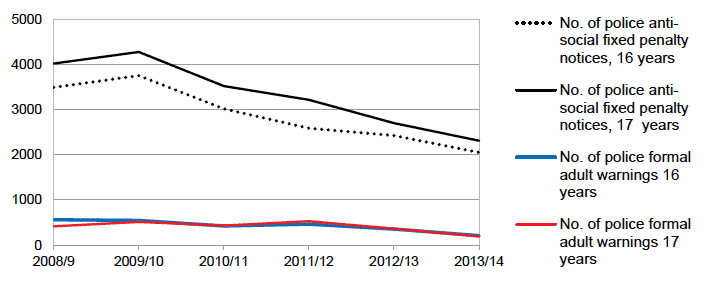
Source: Scottish Government (2014b) Criminal Proceedings 2013/14
This shows that across Scotland, more anti-social fixed penalty notices were issued to young people than police warnings: 4,364 fixed penalty notices were issued to 16 and 17 year olds in 2013/14, compared to 401 police warnings. The varying use of sanctions is not easily explained and further research is needed to understand the underlying rationales. The overall number of fixed penalty notices issued to 16 and 17 year olds fell by 46 per cent between 2009/10 and 2013/14, which suggests a positive trend. Research suggests that fines do not reduce the risk of reoffending and in some cases may increase the likelihood of re-offending. Fines can also carry the risk of a custodial sentence, should a person default ( NIACRO, 2008).
3.10 Role of Partnership Working in Meeting Short/Medium Term Goals
Partnership working is the cornerstone of WSA. Healthy, joined-up and conducive working relationships between the primary WSA partners were reported in all three local authorities. Whilst some professional relationships existed previously, especially in Authority A, it is evident that WSA has had a galvanising effect and has introduced new partners to further diversify and strengthen the process. Improved relationships have fostered more information sharing between partners, and it was reported that this had facilitated improved outcomes for young people by dint of stakeholders at all levels being better informed as to the context in which the offending behaviour has taken place and collective identification of the most appropriate response. Welfare has therefore become the focus, as described by a police officer in one authority:
"It's broken down barriers, even with the police, because now folk are saying they're working with a young child but they've got a concern. So in the past they wouldn't. …. They would have kept to themselves because there's no point telling the police because it's not an offence. Phone the police to say that X has got Y coming to a flat: what are the police going to do about that? Now they share that because they think; 'okay why is that guy going in there? She's 14: He's 20. Why is that happening? Who is he? Right, that's coming in."
Practitioner relationships are considered to be reinforced by formal WSA processes. For example, one police officer commented on how partnership working promoted greater levels of trust and understanding with local partners, resulting in more effective data-sharing:
"[Previously] it was very much how you got on with that counterpart in the other agency as to what information you got back. All agencies are quite territorial, 'That's my information and you're not getting it'. Or people would always cite data protection as the Holy Grail".
A social worker in one authority considered there to be more pronounced partnership working between social work and education services since the roll out of the WSA, in some contrast to prior working relations:
"I remember when I first started social work, and education was like this all the time, they were not always fighting but… I think in terms of child protection when I first started it was all just starting to change and now it's all really good in terms of all the sharing and stuff. I think that had all improved and got better anyway; it's not because of WSA, but I think WSA has been a part of it".
An earlier evaluation of EEI by MacQueen and Fraser (2011) also found a level of reticence in terms of information sharing by health practitioners. In one authority, the police attributed major improvements in partnership working and information sharing with health to the implementation of the WSA:
"The health partners at the time, the people that were coming to the meetings were either a) getting the information and not sharing it at the meetings or b) just not getting the information at all and so weren't able to share anything at the meeting. And that was due to probably a lack of awareness within their line management structure, as to what they were able to access and what they were allowed to share… So that has improved significantly".
However, not all practitioners were fully on board with the WSA ethos nor were agreeable to information sharing, at least not during the early stages of implementation:
"We've not met total stonewall resistance from anybody, resistance from any organisation [overall]… But some of the hardest discussions I've had have been with social workers or managers. Which I wasn't expecting to be honest, I was maybe a bit naive about that before I came into post. But it's just a cultural change that is going to take a while".
Despite having a healthy relationship with the authority's Procurator Fiscal, the separation of the fiscal marking team from other WSA partners is an area that could be improved upon. Below, a social worker in one authority comments on the how their team have worked to establish relationships with the PF team:
"Getting access to [the PF] team on a regular basis is much trickier because they could be marking for anybody day-to-day and they have potentially ten local authorities all vying for their diversion business: it must be a bit overwhelming sometimes, to be a marker, in that kind of situation. It's tricky to cultivate relationships with the fiscals when it's a big faceless marking team. There's a different fiscal team that deals with justice custody cases and that probably works a bit better here because that's a smaller team and we have met them all and we know one or two names, so we tend to liaise always with them and that's been quite effective in getting some folk, some young people directed straight from custody, which is something that never happened before our team came along".
In terms of addressing the PF workload, greater use of police direct measures might be be encouraged. For example, wider use of informal or formal warnings could help to reduce unnecesssary fiscal marking and reduce the number of cases that are marked for No Further Action.
3.11 Summary
Overall, the evidence presented in this section of the report suggests that there is widespread support for PRS, particularly because it has brought together a wider range of partners to deal with individual cases. The role of the police in facilitating the WSA is well established and promotes good working relationships, with the JLOs in particular acting as drivers for change within Police Scotland. Within the PRS process, offending tends to be treated as another flag for welfare concern rather than the central issue to be dealt with, whilst better information sharing is felt to have led to better individual outcomes. Eligibility for PRS appears to vary across authorities. In some areas it is still predominantly used for under 16s and less often for 16 and 17 year olds. There also appear to be some important gender differences, with priority possibly being given to females for PRS. However, better data are required to determine individual flow through the system and the potential impact of PRS on deterrence from offending.
PRS outcomes tend to vary by authority, for which there are different provisions in terms of the balance of statutory services and third sector organisations. This influenced the ability to share information and make collective decisions, and led to differential access to resources. Diversion from prosecution provides a good example of variation by authority, both in terms of extent and trends over time. It was clear that some authorities prioritise diversion for young people (under 25), while others use diversion for offenders across the age spectrum. In some authorities, the rate of diversion for females was also disproportionately higher than would be expected from their offending rates, although this is an area that deserves further study. The use of other alternatives to prosecution, such as fiscal and police fines and warnings, has decreased in recent years for 16 and 17 year olds although it is not clear if this is due to a reduction in offending or a shift in the use of such disposals.
There is significant support for court support services for young people, although concerns were expressed about other aspects of the court process such as lengthy delays, prolonged use of supervised bail and missed opportunities for supporting young people. There was particular criticism about the lack of skilled staff to deal with demanding cases and the lack of data to monitor the outcome of court cases. The vast reduction in the use of custodial sanctions for young people was welcome, although the funding arrangements for secure care were felt to be a disincentive to its use.
Improvements in partnership working across agencies was reported in all three local authority areas and it was evident that the WSA had been a galvanising factor in driving this change in relationships. Practitioners strongly felt that this had led to improved outcomes for young people, although it was not possible with the data available to determine if this was actually the case. References were made to increased levels of trust and understanding between local partners; more effective data sharing; and better integration of services. However, while strong partnership working within the WSA was perceived to be beneficial, it was not always the case that this was supported by wider partnership working across the local authority sector as a whole.
Contact
There is a problem
Thanks for your feedback